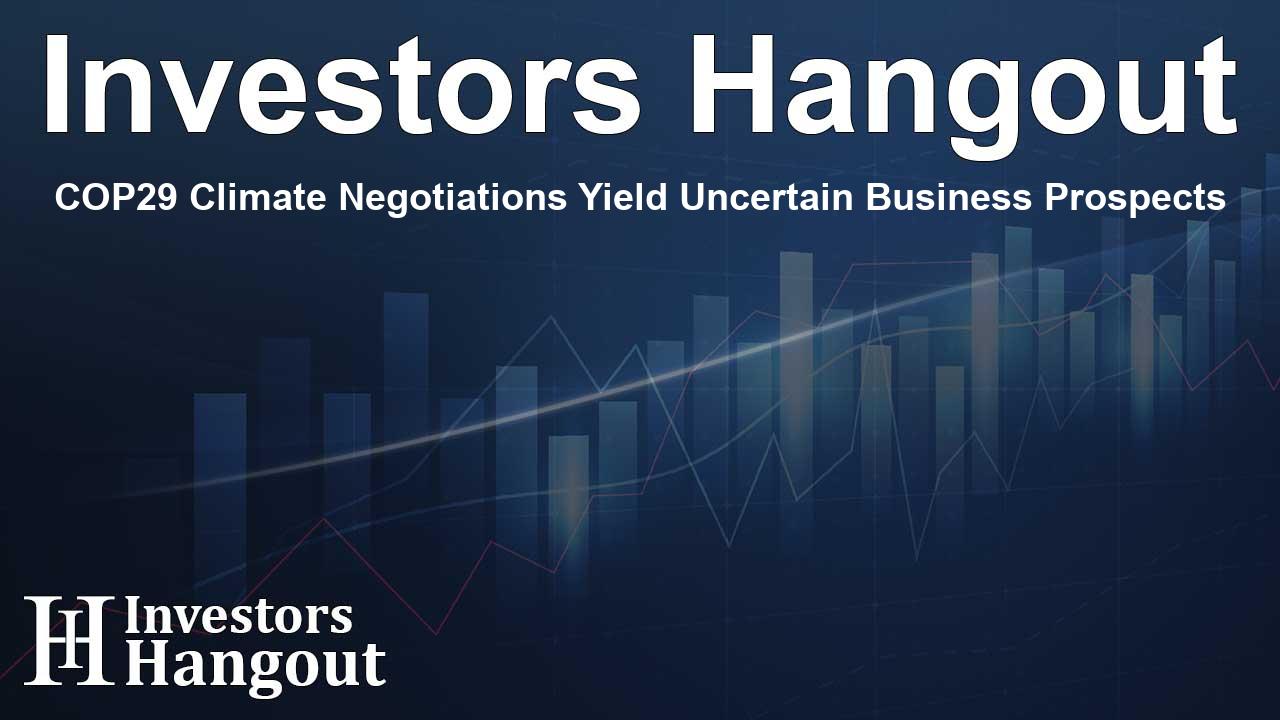COP29 Climate Negotiations Yield Uncertain Business Prospects

COP29 Produces Mixed Messages on Climate Finance
The recent discussions at COP29 have highlighted the complexity of climate negotiations, especially with the world eagerly anticipating robust climate financing and action. According to recent reports, there is considerable potential for billions of dollars to flow through various business sectors if nations can present clear and actionable climate plans by the next summit in Brazil.
The Need for Clear Climate Plans
As countries prepare for the upcoming U.N. climate meeting, they must submit detailed plans that include tangible steps to make climate-related projects feasible and less risky. These plans are not just bureaucratic steps—they're vital to ensuring a smooth transition away from fossil fuels. However, the pace at which these transitions are taking place has become a source of concern among business leaders, with the complexities of changing political landscapes and policies playing a significant role.
The Challenge of Political Uncertainty
Political dynamics can heavily influence climate discussions, especially with the recent election of a certain former president in the U.S. Many observers feel that this could slow progress on climate funding and hinder climate-friendly policies aimed at promoting investments in green initiatives.
The Financial Commitments at COP29
During the two-week summit in Azerbaijan, an agreement was reached for an ambitious target of $300 billion in annual climate finance by 2035. While welcomed, many developing nations expressed skepticism, feeling that this financial commitment is insufficient in supporting their national climate agendas. The private sector's role was frequently mentioned throughout the summit, particularly regarding a pledge from a multilateral development bank to mobilize $65 billion of private investment each year.
Investment-Ready Projects
For businesses, the focus now shifts to ensuring that national climate plans include initiatives that are “investment-ready.” This means having specific, actionable steps that investors can evaluate to understand their long-term viability and associated risks. Achieving this will require cooperation from governments to turn lofty climate goals into enforceable regulations and policies.
Emerging Revenue Streams and Challenges
Amidst the negotiations, discussions turned to exploring new potential revenue sources, including taxes on sectors contributing to pollution. This could lead to a reinvigoration of infrastructure projects, particularly in regions deemed high-risk for investment. However, the delay in achieving a distinct green energy transition raises alarms, underscored by geopolitical factors such as the ongoing conflict in Ukraine.
The Impact of Global Events
Current global crises have resulted in many companies reassessing their green strategies. Major corporations like BP and Unilever appear to be pulling back on commitments made at previous meetings, highlighting the need for unwavering focus at future summits to mitigate these pressures. This pullback shows the ongoing influence of fossil fuel interests in the negotiations.
COP29 and Future Communication
While the targets set during COP29 are significant, actual delivery remains to be seen. The failure to advance last year's pledges of moving away from fossil fuels and increasing renewable energy capacity creates additional hurdles. The continued lobbying by fossil fuel sectors casts a long shadow over the hopes of achieving meaningful progress at COP30.
Encouraging Carbon Markets
Contrarily, companies involved in carbon emission projects found some grounds for optimism, as negotiations led to agreements on rules governing the trade of national carbon offsets. A central registry is expected to offer essential tracking capabilities for carbon credits, thus encouraging nations and organizations to participate actively in market opportunities. However, stakeholders remain cautious, as the credibility of such credits hinges on the clear formulation of the frameworks surrounding their trade.
Frequently Asked Questions
What is COP29?
COP29 refers to the 29th session of the Conference of the Parties to the United Nations Framework Convention on Climate Change, where nations discuss global climate issues.
What financial commitments were made at COP29?
Countries agreed to a target of $300 billion in annual climate finance by 2035, though many developing nations believe this amount is insufficient.
How does political climate affect COP initiatives?
Political leaders can influence climate policies and funding availability, impacting overall progress during negotiations and implementation of climate initiatives.
What challenges surround the implementation of climate plans?
Challenges include the need for detailed, investment-ready projects, potential political shifts, and the ongoing influence of fossil fuel interests in negotiations.
What are carbon offsets, and why are they important?
Carbon offsets are credits regulated for reducing carbon emissions and play a crucial role in helping countries achieve their climate targets while attracting investment in sustainable solutions.
About Investors Hangout
Investors Hangout is a leading online stock forum for financial discussion and learning, offering a wide range of free tools and resources. It draws in traders of all levels, who exchange market knowledge, investigate trading tactics, and keep an eye on industry developments in real time. Featuring financial articles, stock message boards, quotes, charts, company profiles, and live news updates. Through cooperative learning and a wealth of informational resources, it helps users from novices creating their first portfolios to experts honing their techniques. Join Investors Hangout today: https://investorshangout.com/
Disclaimer: The content of this article is solely for general informational purposes only; it does not represent legal, financial, or investment advice. Investors Hangout does not offer financial advice; the author is not a licensed financial advisor. Consult a qualified advisor before making any financial or investment decisions based on this article. The author's interpretation of publicly available data shapes the opinions presented here; as a result, they should not be taken as advice to purchase, sell, or hold any securities mentioned or any other investments. The author does not guarantee the accuracy, completeness, or timeliness of any material, providing it "as is." Information and market conditions may change; past performance is not indicative of future outcomes. If any of the material offered here is inaccurate, please contact us for corrections.